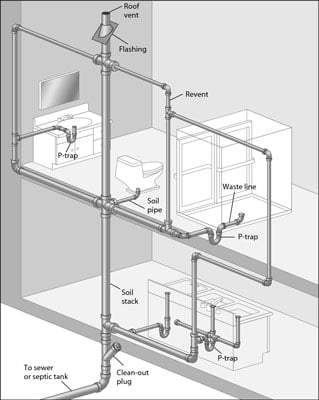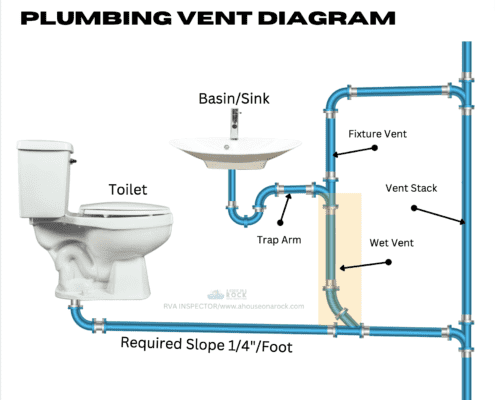The Role of Correct Ventilation in Maintaining Plumbing Systems
The Role of Correct Ventilation in Maintaining Plumbing Systems
Blog Article
We've encountered this great article on What Is A Plumbing Vent & How Do They Work? directly below on the internet and concluded it made good sense to talk about it with you in this article.

Appropriate air flow in pipes systems is frequently overlooked, yet it is essential for maintaining the capability and safety and security of your home's pipes. Air flow assists manage air pressure, prevent the buildup of unsafe gases, and guarantee the reliable removal of waste. In this overview, we will discover the value of proper pipes air flow, just how it functions, and the advantages it gives your plumbing system.
How Air Flow Works in Pipes Systems
Atmospheric Pressure Guideline
Proper air flow preserves well balanced air pressure within the plumbing system. When water flows through pipes, it displaces air. Without ample ventilation, this displacement can produce adverse pressure, causing slow drains or siphoning of water from catches, which can create unpleasant smells to permeate right into the home.
Avoiding Drain Gas Accumulation
Among the most important features of pipes vents is to avoid drain gases, such as methane and hydrogen sulfide, from collecting within the home. These gases can present severe health and wellness dangers and are extremely flammable. Vent pipelines allow these gases to escape securely outdoors.
Helping in Waste Removal
Ventilation assists in the efficient elimination of wastewater by stopping airlocks in the drain system. When air can flow easily through the vents, it enables water and waste to move efficiently through the pipelines, decreasing the threat of clogs and back-ups.
Advantages of Appropriate Air Flow
Enhanced System Performance
Correctly aerated plumbing systems operate extra efficiently, with less obstructions, faster draining pipes, and less stress on the pipes. This performance prolongs the life expectancy of the pipes system.
Improved Air Top Quality
By protecting against drain gases from entering your home, correct ventilation contributes to far better indoor air high quality, making your living environment healthier and much more comfortable.
Protecting Against Water Damages
Appropriate ventilation aids prevent water from being siphoned out of traps, which can bring about drain gases entering the home and triggering water damages in time.
Steps to Ensure Appropriate Air Flow
Consulting Pipes Codes
Always speak with regional plumbing codes when making or customizing your plumbing system. These codes offer the necessary guidelines for proper venting and guarantee your system fulfills safety standards.
Normal Examination and Maintenance
Normal inspections can help determine potential air flow issues prior to they come to be significant troubles. Maintenance tasks, such as cleansing vent pipelines and looking for clogs, are vital for keeping the system in good working order.
Professional Installment
For new installments or major alterations, it's smart to hire a professional plumbing. They have the knowledge to make sure the air flow system is appropriately made and set up according to code.
Recognizing Air Flow in Pipes
Ventilation in pipes describes the network of pipes that allow air to flow through the drainage system. These vents offer several purposes, including controling atmospheric pressure within the pipes, stopping sewage system gases from going into the home, and aiding in the smooth circulation of wastewater.
Types of Pipes Vents
Main Stack Vent
The main stack air vent, additionally called the air vent pile, is the main air vent in a plumbing system. It expands from the primary drainpipe align through the roof, permitting gases to escape and fresh air to enter the system.
Branch Vent
Branch vents link to the major pile air vent and offer specific components, such as sinks, bathrooms, and showers. These vents make certain that each fixture has appropriate ventilation to function properly.
Air Admittance Valve (AAV).
An Air Admittance Shutoff (AAV) is a one-way shutoff that enables air to go into the plumbing system without the need for a standard vent pipe expanding via the roof covering. AAVs are frequently made use of in restorations or areas where installing a typical air vent is impractical.
Indicators of Poor Ventilation in Pipes.
Slow Draining Fixtures.
If your sinks, tubs, or commodes are draining slowly, it could be a sign of inadequate ventilation. Inadequate air flow can create a vacuum cleaner result, making it tough for water to drain appropriately.
Gurgling Seems.
Gurgling audios coming from drains pipes are frequently a result of air being drawn via water traps because of unfavorable stress in the pipelines. This is a clear indication of insufficient ventilation.
Unpleasant Odors.
Drain smells inside your home are a red flag that your plumbing system is not effectively ventilated. This could imply that drain gases are not being sufficiently aired vent outside, causing potentially unsafe problems.
Typical Air Flow Blunders.
Poor Vent Sizing.
Making use of undersized air vent pipelines can cause poor air circulation and stress imbalances in the system. It's essential to use vents that fulfill the certain needs of your plumbing system.
Improper Vent Positioning.
Putting vents also far from the components they serve can lower their efficiency. Correct placement ensures that air can stream openly and successfully through the system.
Disregarding Code Needs.
Building regulations supply particular guidelines for plumbing air flow. Overlooking these codes can lead to a system that falls short to function properly and might lead to costly fixings or carcinogen.
Verdict.
Proper air flow is a vital component of any plumbing system, guaranteeing that it functions efficiently and safely. By comprehending the relevance of ventilation, acknowledging the signs of poor ventilation, and taking steps to keep your system, you can avoid pricey concerns and safeguard your home's air high quality.
4 Things You Should Know About Your Plumbing Vents
What Plumbing Vents Are
Also called a vent stack, a plumbing vent is a vertical pipe attached to your drain line that runs through your roof. The plumbing vent pipe, or plumbing air vent, removes gas and odors from your plumbing system and allows fresh air to enter the pipes, helping the water to flow out of the drain pipes.
What Plumbing Vents Do
Plumbing vents have two basic functions. One of which is to allow unpleasant smelling wastewater and sewer gasses to escape your plumbing system instead of entering your home. Plumbing vent pipes are typically located on roofs, away from windows, to ensure the fumes exit the home completely.
The other function of the plumbing vent is to move fresh air into your plumbing system. This helps move water through every plumbing fixture in your house, like toilets and sink drains. Think of the way in which you need to let a little air into the bottle as you pour soda in order to make the drink flow smoothly.
Different Types of Plumbing Vents
True vent: This is the most common vent option. In simplest terms, a true vent is a vertical pipe attached to your drain line that exits through the roof. They often function as the main vent that other fixtures can connect to. Re-vent pipe or auxiliary vent: Attached to the drain line near specific plumbing fixtures, re-vent pipes run up and over to connect to the main vent. Common vent: Two plumbing fixtures installed on opposite sides of a wall are typically tied into the vent stack using something known as a sanitary cross. Wet vent: This venting option operates as a drain pipe and a vent at the same time. Wet vent drainage systems drain water from one fixture while venting the air from another. Although they’ve been used for over 100 years, wet vent systems have only recently been added to the plumbing code in many areas. If you’re planning on installing one in a bathroom remodel, make sure you check your local code prior to construction. Loop vent: For free-standing fixtures like kitchen island sinks, loop vents are ideal. These vent pipes run under the floor, rise from the P-trap, and create a loop inside the cabinet sink. Air admittance valve: An AAV is a one-way mechanical valve typically installed at the site of the plumbing fixture. AAVs allow venting to occur without having to tie into a larger venting system. They’re ideal for venting fixtures where you aren’t able to easily connect to an existing vent system. Common Plumbing Vent Issues
Although vent pipes typically don’t have water flowing through them, they’re still subject to many typical plumbing issues. For example, clogs are one of the most common problems associated with sewer vent pipes. If your vent pipe gets clogged, all of your plumbing fixtures tied into the vent stack will be affected.
A sink with a slow drain that bubbles and gurgles or a strong sewage smell around your toilet are both indicators that your toilet vent pipe is clogged. Because most vent pipes exit through the roof, old leaves, twigs or even a bird’s nest could be clogging the pipe.
Clogs in your vent pipe system cause a buildup of negative pressure, meaning that water won’t be able to flow out of your home very well. It’s similar to putting your finger over the opening of a straw to trap water inside. When you remove your finger, the water is able to flow out of the straw.
If you suspect you have any blockage in your vent, make sure you have a professional come examine the situation. Left unchecked, a blocked air vent can lead to other costly repairs, like leaks and sediment buildup.
Under Pressure
Pipe vents are essential aspects of a home’s plumbing system. Owning a home means learning about all sorts of things you never put much thought into before. But by understanding as much as you can about the important systems of your home, you can keep those budgets intact and those anxiety levels low.
https://www.homeserve.com/en-us/blog/home-improvement/plumbing-vents/

We hope you enjoyed reading our topic on The Upsides of Proper Ventilation in Plumbing Design. Thanks for taking the time to read our article. Sharing is caring. Helping others is fun. Thank-you for your time invested reading it.
Visit Website Report this page